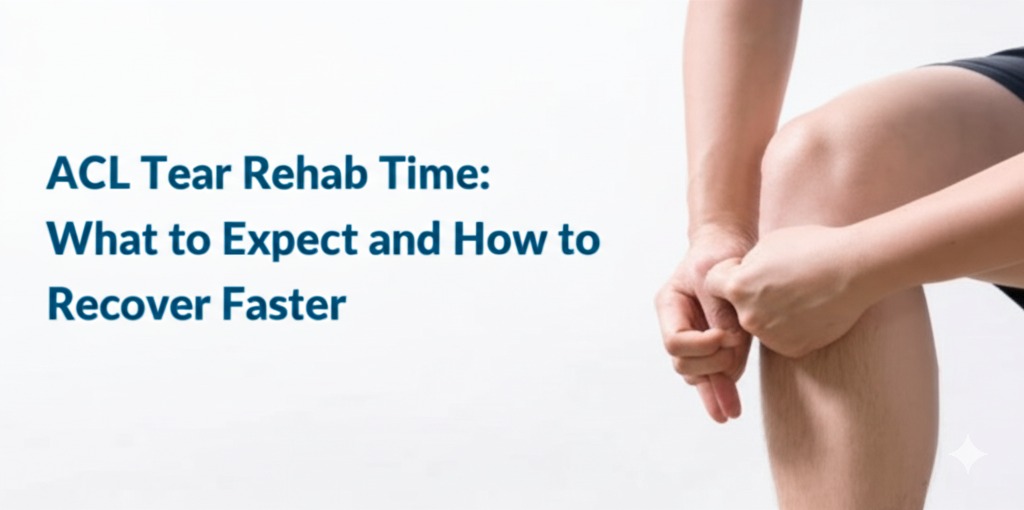An ACL tear is one of the most common — and most feared — injuries among athletes and active individuals. Whether you’re a weekend warrior or a professional athlete, tearing your anterior cruciate ligament (ACL) can feel like a major setback. One of the first questions people ask after the injury is: “How long will it take to recover?”
In this article, we’ll break down everything you need to know about ACL tear rehab time, from recovery timelines to tips for speeding up healing. By the end, you’ll have a clear roadmap for your return to activity — and your best shot at a full comeback.
What Is an ACL Tear?
The anterior cruciate ligament (ACL) is a key stabilizer of the knee. It connects the thigh bone (femur) to the shin bone (tibia) and helps control knee movement during activities like running, jumping, and pivoting.
An ACL tear typically occurs due to:
- Sudden stops or changes in direction
- Direct impact to the knee
- Landing awkwardly after a jump
Symptoms include a popping sound, severe knee pain, swelling, and instability.
Do All ACL Tears Require Surgery?
Not necessarily. The treatment plan and rehab timeline depend on the severity of the tear and the patient’s activity level.
- Partial tears or tears in less active individuals may be treated non-surgically.
- Complete tears in athletes or active individuals usually require ACL reconstruction surgery for optimal knee stability.
ACL Tear Rehab Time: General Timeline
The rehabilitation process for an ACL tear can take anywhere from 6 to 12 months, depending on various factors.
📆 Typical ACL Rehab Timeline:
Weeks 1–2: Post-Injury or Post-Surgery
- Focus: Reducing swelling and pain
- Activities: Icing, rest, compression, and elevation (RICE), gentle range-of-motion exercises
- Tools: Crutches, knee brace (if post-surgery)
Weeks 2–6: Early Rehabilitation
- Goal: Regain range of motion and muscle activation
- Focus: Quad activation, light strength exercises, walking with assistance
- Progress: Reduced dependence on crutches
Weeks 6–12: Building Strength and Stability
- Activities: Leg presses, step-ups, stationary cycling
- Milestone: Walking unassisted, improved balance and control
Months 3–6: Return to Low-Impact Activity
- Goals: Improve agility, coordination, and strength
- Activities: Swimming, elliptical, resistance training
- Focus: Neuromuscular training and core strengthening
Months 6–12: Return to Sport
- Clearance: Must pass functional tests and be cleared by a healthcare provider
- Includes: Sport-specific drills, plyometrics, running, cutting maneuvers
- Caution: Risk of reinjury is highest in this stage without proper readiness
Factors That Affect ACL Tear Rehab Time
Not everyone recovers at the same pace. Several variables can speed up or slow down your rehab timeline:
🔹 Type of ACL Tear
- Partial vs. complete tears have different recovery needs.
- Surgery adds recovery complexity and time.
🔹 Age and Physical Fitness
- Younger and more fit individuals often recover faster due to stronger muscles and better healing capacity.
🔹 Surgical Technique Used
- Autografts (your own tissue) vs. allografts (donor tissue) have slightly different healing profiles.
🔹 Commitment to Rehab
- Sticking to your physical therapy plan is critical for a full and timely recovery.
Tips to Speed Up Your ACL Recovery
Rehabilitation is a marathon, not a sprint. However, there are ways to enhance your progress safely:
- Stay consistent with your physical therapy appointments.
- Strengthen surrounding muscles, especially quads, hamstrings, and glutes.
- Eat a balanced diet rich in protein, vitamins C and D, and collagen.
- Stay hydrated and get plenty of sleep to support tissue healing.
- Avoid pushing too hard, too soon — reinjury is common with premature returns to sport.
When Can You Return to Sports?
This is the golden question. On average, most athletes return to competitive sports between 8 to 12 months post-injury, depending on:
- Strength and range of motion
- Passing functional movement tests
- Psychological readiness
Rushing back too early increases your chance of a second ACL tear — especially in young athletes.
Final Thoughts: Be Patient, Stay Strong
ACL tear rehab time isn’t just about healing — it’s about rebuilding your strength, confidence, and stability. While it can take several months, following a structured rehab program and listening to your body will give you the best chance of returning stronger than before.
If you’ve recently torn your ACL or are starting your rehab journey, talk to your orthopedic specialist or physical therapist about your customized recovery plan.
Your comeback story starts now.

Kallie Snyder is an author at Stonegate Health Rehab, providing valuable insights, recovery guidance, and rehab resources to help individuals achieve better health and well-being.
